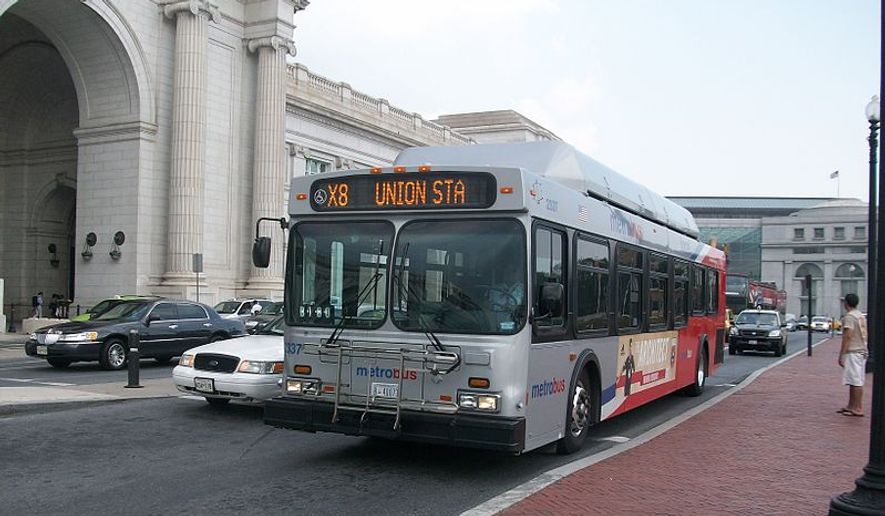OPINION:
In honor of Mayor Muriel Bowser proclaiming last Monday to be “Take the Bus to Work” Day, I rode downtown on the 42 bus for my mile-and-a-half commute and it actually saved me a couple of minutes more than my normal method of transport downtown, which is walking.
The fact that a bus moves scarcely faster than people on foot illustrates a stark reality: Most people eschew the bus not because it’s dirty or inconvenient or declasse but because it is usually the slowest way there is to get from point A to point B. Congestion on our city’s roads is only partly to blame: The reality is that the city implicitly places a much higher priority on protecting on-street parking than speeding up bus transit. As a result, an army of parked cars serve to dramatically slow bus traffic all across town.
For instance, Connecticut Avenue NW has rush hour parking bans from 7-9:30 a.m. going south and 4-6:30 p.m. going north. The purpose of this is to free the parking lanes for automobiles. Given that buses remain in the right lane unless compelled to merge, this should theoretically give them a lane with little congestion.
However, drivers blithely ignore rush hour parking restrictions in this city with little consequence. On Connecticut Avenue, for instance, cars can still be found parked on downtown streets at 4:45 most days, and by 6 p.m. at the latest they begin parking again. In the morning, parked cars appear before 9 a.m. on most streets with rush hour parking restrictions.
And even within the shortened rush hour buses still need to account for taxis, Uber drivers and postal trucks that sit in the right lane for minutes at a time.
The city will not ticket a postal truck under any circumstances, and they abuse this privilege: Much of last year I would exchange a nod each evening on my walk home with a mailman taking a cigar break with his truck parked directly in front of a bus stop on Connecticut, which invariably resulted in a traffic jam.
It is not just the ineffectual rush hour restrictions that slow bus traffic: The city’s tendency to treat on-street parking as a scarce natural resource needlessly slows bus traffic as well.
For instance, when the southbound 42 bus makes its stop a block north of Florida Avenue NW it must invariably pause for 20-30 seconds in order to merge into traffic. This pause invariably causes it to stop at the red light at Florida, costing it another 30-40 seconds. If the four parking spaces in front of its stop were not there the bus could remain in the right lane and not need to merge.
These spots are literally a one-minute walk from a parking garage on Florida Avenue. In essence, we prioritize saving a minute or two of time for the dozen or so people who park there each day against saving a minute or two for the few thousand people who take the bus. The same thing occurs on southbound Connecticut and M Street NWas well, along with a couple of northbound stops on this route.
The eastbound 96 bus — another bus I occasionally ride — has similar blockades created by parked cars where a handful of parked cars slow bus traffic.
In fact, our bus routes are littered with such trade-offs, with no one bothering to object. The reason for the status quo is obvious: People who own cars and park on city streets tend to be wealthier, more politically active and apt to complain loudly if their privileges are altered. An attempt to increase the puny $25 annual parking registration fee created loud objections that quickly caused the D.C. Council to back down.
Bus riders don’t complain about the lousy status quo so it is easy to keep it as it is, and the result of this dynamic is that thousands of bus riders spend a few more minutes on their commute to save a few people a minute or two when they park their car.
If we really want to increase bus ridership, we need to speed up bus commutes. That would entail enforcing rush hour parking restrictions — with fines more than $100 for parking or even standing in protected lanes and traffic police permanently stations in key intersections — and eliminating all on-street parking that interferes with bus traffic.
To reduce the vast excess demand for on-street parking that begets our parking problem, we also replace the $25 parking permit fee with the auctioning of permits, limiting the number auctioned to the number of available spots in a given neighborhood. The revenue generated can be used to subsidize Metro transit for low-income commuters in the neighborhood.
Mayor Bowser has shown herself to be willing to take on the wealthy denizens in other venues: If she tackled the unreasonable parking privileges she could improve the lot of everyone who rides a bus at a very small cost to everyone else.
Ike Brannon is a senior fellow at the Jack Kemp Foundation.




Please read our comment policy before commenting.